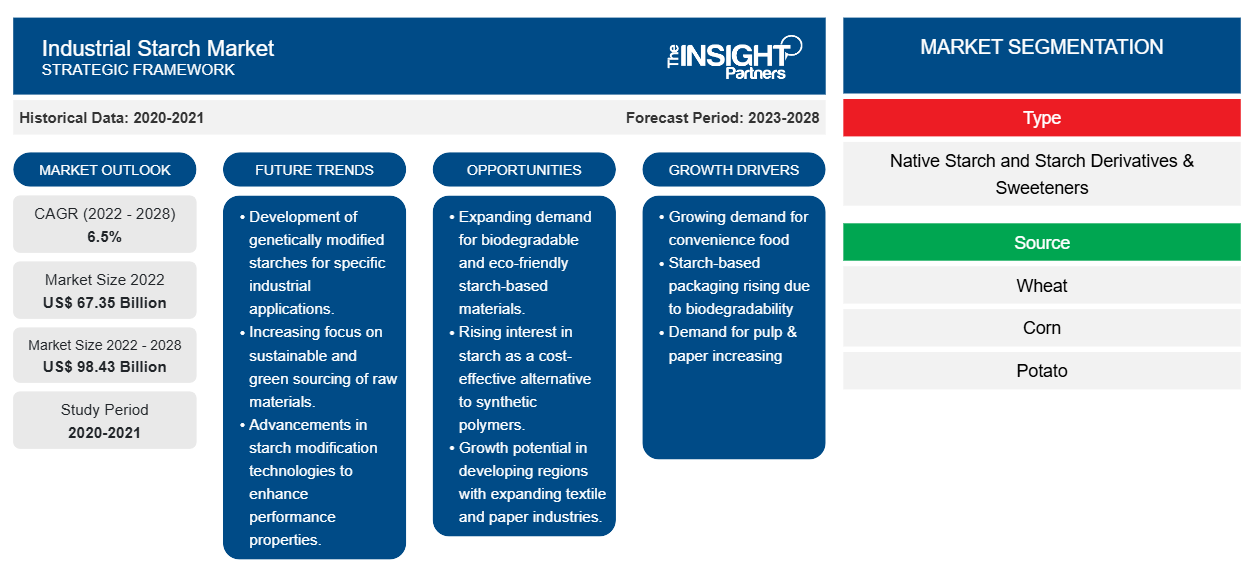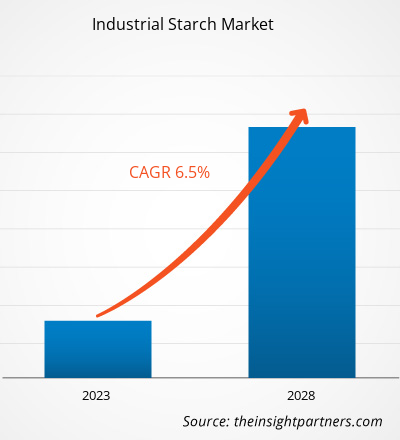Industrial Starch Market Outlook and Strategic Insights by 2028
Historic Data: 2020-2021 | Base Year: 2022 | Forecast Period: 2023-2028Industrial Starch Market Forecast to 2028 - COVID-19 Impact and Global Analysis By Type (Native Starch and Starch Derivatives & Sweeteners), Source (Wheat, Corn, Potato, Cassava, and Others), and Application (Food & Beverages, Pulp & Paper, Animal Feed, Pharmaceuticals, and Others)
- Report Date : Jul 2022
- Report Code : TIPRE00021147
- Category : Food and Beverages
- Status : Published
- Available Report Formats :


- No. of Pages : 182
[Research Report] The industrial starch market is expected to grow from US$ 67,353.01 million in 2022 to US$ 98,426.74 million by 2028; it is estimated to grow at a CAGR of 6.5% from 2022 to 2028.
Starch is a complex carbohydrate derived from wheat, corn, potato, tapioca, and rice. It is a great source of energy. Starch is a thickening/gelling agent and stabilizer in a wide range of food and beverages, including bakery and confectionery products, soups, sauces, frozen desserts, dairy creamers, and ready-to-drink beverages. The demand for convenience food is increasing globally due to consumers' hectic lifestyles and high per capita income. Moreover, paper-based food packaging needs a coating to prevent water or oxygen from penetrating the packaging and spoiling the foodstuff inside. Usually, this protective coating is manufactured from petroleum-based plastic. However, manufacturers are adopting bio-based and eco-friendly raw materials for paper-based food packaging coating with increasing awareness about the negative impact of petroleum-based plastic on the environment. Starch-based packaging characteristics such as biodegradability and affordability are propelling popularity among manufacturers.
In the past few years, the demand for starch in the pulp & paper industry has grown significantly with the scaled-up operations in this industry. The booming e-commerce industry in contributes significantly to the demand for corrugated paperboards. Moreover, a notable shift toward plastic-free packaging to ensure environmental sustainability is propelling the demand for sustainable packaging materials. According to research conducted by Roquette Frères, the consumption of industrial starch in corrugated board manufacturing increased by 6% in 2020 due to the significant rise of the e-commerce sector amid the COVID-19 pandemic. Thus, the surging demand for starch in the paper & paperboard industry is bolstering the industrial starch market.
Customize This Report To Suit Your Requirement
You will get customization on any report - free of charge - including parts of this report, or country-level analysis, Excel Data pack, as well as avail great offers and discounts for start-ups & universities
Industrial Starch Market: Strategic Insights

-
Get Top Key Market Trends of this report.This FREE sample will include data analysis, ranging from market trends to estimates and forecasts.
Manufacturers around the world are benefitting from the growth of the e-commerce industry. Across the globe, various manufacturers and e-commerce channels are promoting the use of sustainable and eco-friendly packaging materials. The industrial starch market growth is expected to boost with this increasing adoption of sustainable packaging materials by the e-commerce industry. Indian e-commerce companies Myntra and Flipkart have adopted to reduce or eliminate the use of single-use plastic in their packaging materials. Moreover, government policies to reduce plastic pollution is expected to boost the demand for industrial starch.
Market Insights
Wide Application Scope of Industrial Starch Fuels Growth of Market
The application range of industrial starches in various end-use industries has expanded in recent years. It is used as a thickening, gelling, and binding agent in a wide range of food and beverages, including bakery, soups and salad dressings, confectionery, sauces, ice creams, fruit drinks, and dairy products. Starch is also used in non-food applications such as pulp & paper, pharmaceuticals, and animal feed. In the pharmaceutical industry, starch is used as an excipient and binding agent in tablet making. Moreover, starch-based materials are a perfect solution for biodegradable food packaging materials that help to reduce environmental pollution.
Type Insights
Based on type, the industrial starch market is segmented into native starch and starch derivatives and sweeteners. In 2021, the starch derivatives and sweeteners segment dominated the market. The growing demand for food and beverages, due to the increase in disposable income levels and increasing global population, and the use of starch derivatives in the food and beverage industries is the most important growth driver for the starch derivatives segment of the industrial starch market.
Agrana Beteiligungs-AG; ADM; Ingredion Incorporated; Roquette Frères; Tereos Group; Cargill, Incorporated; Tate & Lyle PLC; Grain Processing Corporation; Royal Cosun; and AVEBE are among the key players operating in the industrial starch market. The leading players adopt several strategies, such as mergers & acquisitions and product launches, to expand their geographic presence and consumer base.
Report Spotlights
- Progressive trends in the industrial starch industry to help players develop effective long-term strategies
- Business growth strategies adopted by companies to secure growth in developed and developing markets
- Quantitative analysis of the global industrial starch market from 2021 to 2028
- Estimation of the demand for industrial starch across various industries
- Porter’s Five Forces analysis to illustrate the efficacy of buyers and suppliers operating in the industrial starch industry
- Recent developments to understand the competitive market scenario and the demand for industrial starch
- Market trends and outlook coupled with factors governing the growth of the industrial starch market
- Understanding regarding the strategies that underpin commercial interest with regard to the market growth, aiding in the decision-making process
- Industrial starch market size at various nodes of market
- Detailed overview and segmentation of the market as well as its industry dynamics
- Industrial starch market size in various regions with promising growth opportunities
The regional trends and factors influencing the Industrial Starch Market throughout the forecast period have been thoroughly explained by the analysts at The Insight Partners. This section also discusses Industrial Starch Market segments and geography across North America, Europe, Asia Pacific, Middle East and Africa, and South and Central America.
Industrial Starch Market Report Scope
| Report Attribute | Details |
|---|---|
| Market size in 2022 | US$ 67.35 Billion |
| Market Size by 2028 | US$ 98.43 Billion |
| Global CAGR (2022 - 2028) | 6.5% |
| Historical Data | 2020-2021 |
| Forecast period | 2023-2028 |
| Segments Covered |
By Type
|
| Regions and Countries Covered |
North America
|
| Market leaders and key company profiles |
|
Industrial Starch Market Players Density: Understanding Its Impact on Business Dynamics
The Industrial Starch Market is growing rapidly, driven by increasing end-user demand due to factors such as evolving consumer preferences, technological advancements, and greater awareness of the product's benefits. As demand rises, businesses are expanding their offerings, innovating to meet consumer needs, and capitalizing on emerging trends, which further fuels market growth.

- Get the Industrial Starch Market top key players overview
The "Industrial Starch Market Analysis to 2028" is a specialized and in-depth study of the chemicals & materials industry, focusing on the market trend analysis. The report aims to provide an overview of the market with detailed segmentation. The industrial starch market is segmented on the basis of type, source, application, and geography. Based on type, the industrial starch market is segmented into native starch and starch derivatives & sweeteners. Based on source, the market is segmented into wheat, corn, potato, cassava, and others. Based on application, the market is segmented into food & beverages, pulp & paper, animal feed, pharmaceuticals, and others. Based on geography, the is segmented into five main regions North America, Europe, Asia Pacific, the Middle East & Africa, and South & Central America. In 2021, Asia Pacific dominated the industrial starch market.
Frequently Asked Questions
What are the drivers for the growth of the global industrial starch market?
Can you list some major players operating in the global industrial starch market?
In 2021 which region was the fastest growing in the global industrial starch market?
What are the trends for the global industrial starch market?
Based on the application, which segment led the global industrial starch market in 2021?
Which type segment is the fastest growing in the industrial starch market globally?
Habi is a seasoned Market Research Analyst with 8 years of experience specializing in the Chemicals and Materials sector, with additional expertise in the Food & Beverages and Consumer Goods industries. He is a Chemical Engineer from Vishwakarma Institute of Technology (VIT) and has developed deep domain knowledge across industrial and specialty chemicals, paints and coatings, paper and packaging, lubricants, and consumer products. Habi’s core competencies include market sizing and forecasting, competitive benchmarking, trend analysis, client engagement, report writing, and team coordination—making him adept at delivering actionable insights and supporting strategic decision-making.
- Historical Analysis (2 Years), Base Year, Forecast (7 Years) with CAGR
- PEST and SWOT Analysis
- Market Size Value / Volume - Global, Regional, Country
- Industry and Competitive Landscape
- Excel Dataset
Testimonials
The Insight Partners' SCADA System Market report is comprehensive, with valuable insights on current trends and future forecasts. The team was highly professional, responsive, and supportive throughout. We are very satisfied and highly recommend their services.
RAN KEDEM Partner, Reali Technologies LTDsI requested a report on a very specific software market and the team produced the report in a few days. The information was very relevant and well presented. I then requested some changes and additions to the report. The team was again very responsive and I got the final report in less than a week.
JEAN-HERVE JENN Chairman, Future AnalyticaWe worked with The Insight Partners for an important market study and forecast. They gave us clear insights into opportunities and risks, which helped shape our plans. Their research was easy to use and based on solid data. It helped us make smart, confident decisions. We highly recommend them.
PIYUSH NAGPAL Sr. Vice President, High Beam GlobalThe Insight Partners delivered insightful, well-structured market research with strong domain expertise. Their team was professional and responsive throughout. The user-friendly website made accessing industry reports seamless. We highly recommend them for reliable, high-quality research services
YUKIHIKO ADACHI CEO, Deep Blue, LLC.This is the first time I have purchased a market report from The Insight Partners.While I was unsure at first, I visited their web site and felt more comfortable to take the risk and purchase a market report.I am completely satisfied with the quality of the report and customer service. I had several questions and comments with the initial report, but after a couple of dialogs over email with their analyst I believe I have a report that I can use as input to our strategic planning process.Thank you so much for taking the extra time and making this a positive experience.I will definitely recommend your service to others and you will be my first call when we need further market data.
JOHN SUZUKI President and Chief Executive Officer, Board Director, BK TechnologiesI wish to appreciate your support and the professionalism you displayed in the course of attending to my request for information regarding to infectious disease IVD market in Nigeria. I appreciate your patience, your guidance, and the fact that you were willing to offer a discount, which eventually made it possible for us to close a deal. I look forward to engaging The Insight Partners in the future, all thanks to the impression you have created in me as a result of this first encounter.
DR CHIJIOKE ONYIA MANAGING DIRECTOR, PineCrest Healthcare Ltd.Reason to Buy
- Informed Decision-Making
- Understanding Market Dynamics
- Competitive Analysis
- Identifying Emerging Markets
- Customer Insights
- Market Forecasts
- Risk Mitigation
- Boosting Operational Efficiency
- Strategic Planning
- Investment Justification
- Tracking Industry Innovations
- Aligning with Regulatory Trends




















 Get Free Sample For
Get Free Sample For